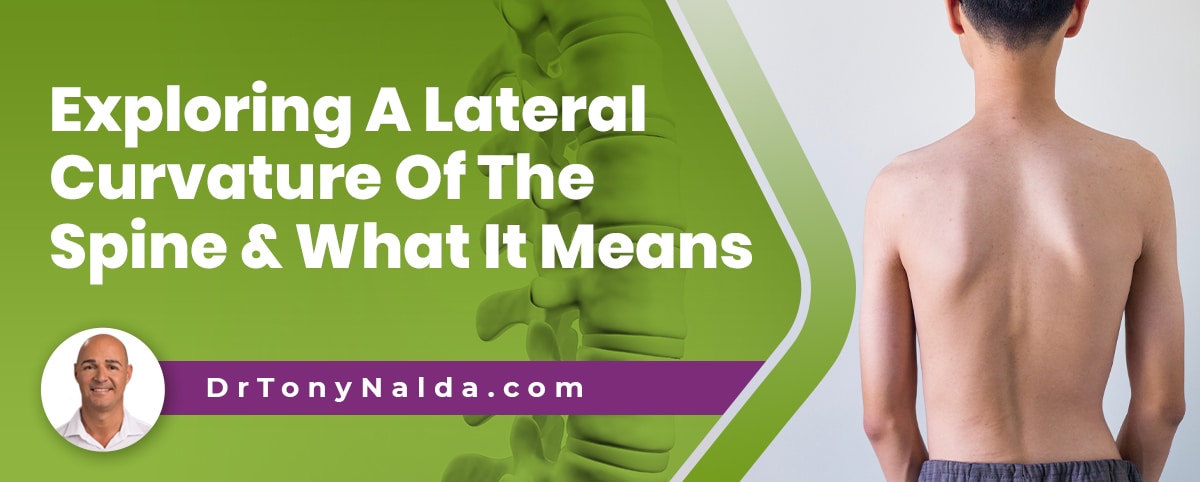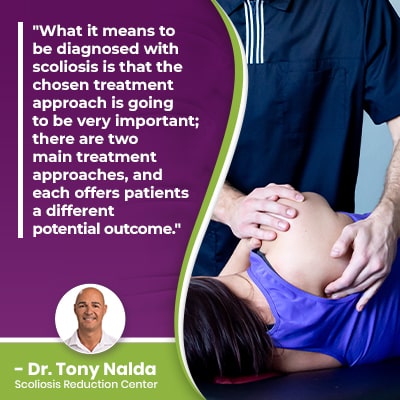Exploring A Lateral Curvature Of The Spine & What It Means

The development of an unnatural spinal curvature means a lot of uneven forces are being introduced to the body, and this can affect it in a number of ways. While scoliosis is progressive and incurable, it can be highly treatable, especially with early detection and intervention.
A lateral curvature of the spine is a sideways curvature of the spine, and when it's accompanied by rotation and has a minimum Cobb angle measurement of 10 degrees, this is scoliosis. Scoliosis is a progressive condition; proactive treatment is important.
Scoliosis can be a complex condition to treat, so let's start our exploration of what it means to have an unnatural lateral curvature of the spine with how it's diagnosed.
Table of Contents
Diagnosing Idiopathic Scoliosis
According to the Scoliosis Research Society, there are currently close to seven million people living with scoliosis in the United States alone, and while mandatory screening was once conducted at schools across the States, that has since changed.
Now, the onus of recognizing the condition's early signs falls on the shoulders of patients themselves, and parents and/or caregivers.
While there are no treatment guarantees, there are fewer limits to what can be achieved with treatment when a condition is diagnosed early in its progressive line, when it's going to be the most responsive and the simplest to treat.
So the first step towards a scoliosis diagnosis is awareness of the condition's early signs, the condition's prevalence, and the benefits of early detection.
Scoliosis involves the development of an unnatural lateral curvature of the spine (side-to-side), with rotation, meaning the spine doesn't just bend unnaturally, but also twists, and the vertebral rotation makes scoliosis a complex 3-dimensional condition.
A scoliotic curve also has to be of a minimum size to be officially diagnosed as scoliosis: Cobb angle measurement of at least 10 degrees.
 As the spine gives the body structure, enables flexible movement, absorbs and distributes mechanical stress, and the spinal cord works with the brain to form the central nervous system, a spine with an abnormal lateral curvature can cause a number of issues.
As the spine gives the body structure, enables flexible movement, absorbs and distributes mechanical stress, and the spinal cord works with the brain to form the central nervous system, a spine with an abnormal lateral curvature can cause a number of issues.
There are also different types of scoliosis a person can develop, and the most common type of childhood scoliosis and adult scoliosis is idiopathic scoliosis, and the idiopathic designation means we don't fully understand what triggers its initial onset.
Idiopathic scoliosis accounts for 80 percent of known diagnosed cases, while the remaining 20 percent are considered atypical and are associated with known causes: neuromuscular scoliosis, degenerative scoliosis, and congenital scoliosis.
We do, however, know what triggers scoliosis progression: growth and development.
As a progressive condition, being diagnosed idiopathic scoliosis means it's virtually guaranteed to get worse over time, so let's talk about what that means.
Scoliosis Progression
To be diagnosed with scoliosis means being diagnosed with a progressive and incurable condition; however, when treated proactively, it can be highly treatable, and scoliosis patients don't have to lead lives of limitations.
Scoliosis progressing means the size of the lateral curvature of the spine is increasing, as are the condition's uneven forces, and their effects.
As the unnatural spinal curve is increasing in size, the spine is becoming more rigid, and that makes it less responsive to treatment, and can also make it difficult for patients to perform certain therapeutic exercises that are key to treatment.
The condition's uneven forces don't just affect the spine, but also its surrounding nerves and muscles, and if left to progress, a muscle imbalance can also develop as the muscles surrounding the spine are pulled in different directions.
The muscles on one side of the spine can become stretched and loose from overuse, while the muscles on the opposite side can become weak from underuse.
Condition severity is determined by a patient's Cobb angle measurement, and the higher a patient's Cobb angle, the more the vertebral bodies at the curve's apex are tilted, and the more noticeably the condition is going to affect the body:
- Mild scoliosis: Cobb angle measurement of between 10 and 25 degrees
- Moderate scoliosis: Cobb angle measurement of between 25 and 40 degrees
- Severe scoliosis: Cobb angle measurement of 40+ degrees
- Very-severe scoliosis: Cobb angle measurement of 80+ degrees
So the condition's severity levels are also its progressive line; where a scoliosis is at the time of diagnosis isn't indicative of where it will stay; only proactive treatment can work towards counteracting the condition's progressive nature.
Scoliosis Treatment Options
 What it means to be diagnosed with scoliosis is that the chosen treatment approach is going to be very important; there are two main treatment approaches, and each offers patients a different potential outcome.
What it means to be diagnosed with scoliosis is that the chosen treatment approach is going to be very important; there are two main treatment approaches, and each offers patients a different potential outcome.
Traditional scoliosis treatment involves a lot of watching and waiting and commonly funnels patients towards spinal fusion surgery: a costly, invasive, and risky procedure.
Modern conservative treatment is my specialty, and here at the Scoliosis Reduction Center, it involves the integration of multiple forms of treatment for the best potential results.
Scoliosis generally progresses faster in children than in adult scoliosis, and this is because once skeletal maturity is reached, the trigger of growth is removed, so when treating scoliosis in children, a focus is on monitoring for progression and counteracting progression during growth, so there is more time to treat scoliosis in adults because rapid-phase progression is unlikely.
Chiropractic Care
Once scoliosis is diagnosed through a physical examination and x-ray imaging, structural scoliosis needs to, first and foremost, be impacted on a structural level, and this is worked towards through chiropractic care and a curvature reduction.
Chiropractic care involves a series of chiropractic techniques and adjustments that work towards repositioning the most-tilted vertebrae back into alignment with the rest of the spine; this also reduces compression as it takes pressure off the spine's surroundings.
Once I start to see the kind of structural results needed, I can shift the focus of treatment to increasing core strength.
Physical Therapy
As it's not just the spine that's in charge of maintaining its natural curves and alignment, but also its surrounding muscles, physical therapy can help scoliosis by increasing core strength so the spine's surrounding muscles can optimally support it.
Physical therapy can also help improve posture, activate certain areas of the brain for improved brain-body communication, and address any related muscle imbalance and/or muscle spasms.
Corrective bracing
Corrective bracing can help augment corrective treatment results by pushing the spine into a corrective position, and this can be particularly effective on growing spines when treating the condition's most prevalent form: adolescent idiopathic scoliosis, diagnosed between the ages of 10 and 18.
The modern ScoliBrace addresses the shortcomings associated with traditional bracing by pushing, instead of squeezing the spine, addressing the condition's rotational component, and its design is based on a series of comprehensive measurements so each brace is bespoke to its wearer.
Rehabilitation
Rehabilitation is important when it comes to further stabilizing and healing the spine for long-term sustainable treatment results.
While continued chiropractic care is also likely to be necessary, a series of custom-prescribed exercises can help patients establish a home-rehabilitation program that's key to recovery and leading a scoliosis-friendly lifestyle.
Conclusion
When it comes to being diagnosed with an unnatural lateral curvature of the spine, this means one or more vertebrae have become unnaturally tilted, causing the development of an unnatural spine curvature in the cervical spine, thoracic spine, or lumbar spine.
Vertebral abnormalities can cause the spine to become misaligned, and as scoliosis progresses, the misalignment gets worse, and scoliosis symptoms can include postural changes (most common symptom of adolescent idiopathic scoliosis) and pain (most common symptom of adult idiopathic scoliosis).
Scoliosis is the development of an unnatural lateral spinal curvature, and when there is also a rotational component, depending on the age of the patient, this can be diagnosed as congenital scoliosis, infantile scoliosis, juvenile scoliosis, adolescent idiopathic scoliosis, or adult scoliosis.
The reality is that if scoliosis is severe and/or is left untreated, scoliosis surgery can be recommended, and while no one can cure scoliosis, not every patient requires surgical treatment.
A scoliotic spinal deformity that involves an abnormal lateral curvature can be addressed proactively by starting treatment as close to the time of diagnosis as possible, and when successful, the complications and risks associated with spinal surgery can be avoided.
So for those choosing to forgo an orthopedic surgery recommendation, or who simply want to try a less invasive treatment option first, functional scoliosis can be treated conservatively in a way that preserves as much of the spine's natural strength and function as possible, throughout treatment and beyond.
Dr. Tony Nalda
DOCTOR OF CHIROPRACTIC
After receiving an undergraduate degree in psychology and his Doctorate of Chiropractic from Life University, Dr. Nalda settled in Celebration, Florida and proceeded to build one of Central Florida’s most successful chiropractic clinics.
His experience with patients suffering from scoliosis, and the confusion and frustration they faced, led him to seek a specialty in scoliosis care. In 2006 he completed his Intensive Care Certification from CLEAR Institute, a leading scoliosis educational and certification center.
About Dr. Tony Nalda
 Ready to explore scoliosis treatment? Contact Us Now
Ready to explore scoliosis treatment? Contact Us Now





